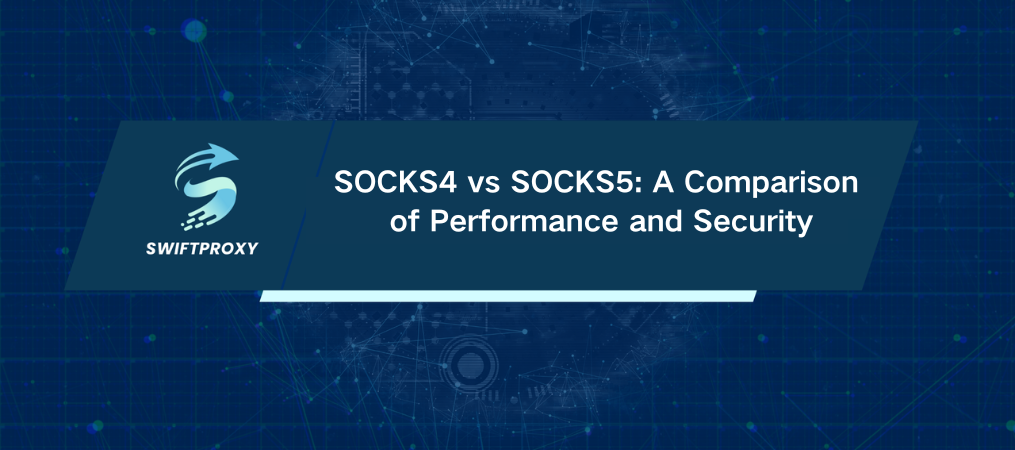SOCKS4 vs SOCKS5: A Comparison of Performance and Security

In today's interconnected world, maintaining privacy and security while navigating the web is no longer optional—it's essential. Whether you're browsing the internet from a coffee shop or managing corporate data, you need a reliable proxy. SOCKS, or Socket Secure, is one of the most widely used networking protocols to ensure your traffic flows securely through the web. But when it comes to SOCKS4 and SOCKS5, what's the real difference? Let's break it down.
A Simple Introduction: SOCKS4 vs SOCKS5
SOCKS4 and SOCKS5 are both proxy protocols, but they're not the same. SOCKS4 was designed in the mid-90s, a solid starting point for internet privacy at the time. SOCKS5, however, was introduced later, evolving to address security and functionality gaps. This evolution turned SOCKS5 into the more versatile and secure choice for today's digital demands.
Key Advantages of SOCKS5
1. Authentication Methods
SOCKS4: Simple. Just IP address-based authentication. No usernames or passwords—just connect and go.
SOCKS5: Flexible and robust. Supports multiple authentication methods, including username/password combinations and even advanced options like GSS-API. This is a big win for anyone looking to add an extra layer of security.
2. Supported Protocols
SOCKS4: Strictly TCP (Transmission Control Protocol). It's good, but not enough for modern needs.
SOCKS5: Supports both TCP and UDP (User Datagram Protocol). UDP is crucial for applications like online gaming, live streaming, and real-time communications—where every millisecond counts.
3. IP Resolution
SOCKS4: Works only with IPv4. That's fine, but in today's increasingly IPv6 world, it's limiting.
SOCKS5: Supports both IPv4 and IPv6. As the internet transitions to IPv6, SOCKS5 is better prepared for the future.
4. Safety
SOCKS4: Doesn't offer encryption, meaning your data is vulnerable to interception.
SOCKS5: Adds encryption support, ensuring that your data travels securely across the network. This is especially important for sensitive operations.
5. Application Scope
SOCKS4: More limited. It can handle basic browsing or static data retrieval, but not much more.
SOCKS5: More versatile. Supports HTTP, HTTPS, FTP, and more. Whether you're transferring files, using secure web applications, or streaming content, SOCKS5 does it all.
When to Use SOCKS4 vs SOCKS5
1. SOCKS4
Simple Browsing: If your primary concern is anonymity, and you're not worried about advanced security, SOCKS4 can still do the job.
Basic Data Collection: For non-sensitive tasks like fetching emails or accessing static web content, SOCKS4 is quick and easy.
2. SOCKS5
Safe File Transfers: Need to securely transfer files over the internet? SOCKS5's advanced authentication and encryption methods provide the protection you need.
Instant Communication: For services like VoIP, video conferencing, or even online gaming, SOCKS5's support for UDP ensures smoother, more reliable data transfer.
Multi-Protocol Access: SOCKS5 is perfect when you need to access a variety of websites and services without compromising security.
SOCKS5 in Real-World Scenarios
1. Home Network
When using SOCKS5 in a home setup, it enhances both security and privacy. The ability to authenticate with a username and password offers an added layer of protection, especially on shared or public networks.
2. Corporate Networks
Security is paramount. SOCKS5's encryption and advanced authentication methods make it a must-have in corporate environments, protecting sensitive data and internal resources from unauthorized access.
3. Public Wi-Fi
Ever used a public Wi-Fi network at a coffee shop or airport? It's a hacker's playground. SOCKS5 mitigates risks with encrypted data transmission, protecting you from prying eyes while you work or browse.
Conclusion
While SOCKS4 might still have its place for basic, low-risk browsing, SOCKS5 is clearly the superior choice for most modern use cases. Its enhanced security features, broader protocol support, and ability to handle real-time data make it indispensable for anyone serious about their internet privacy and security. Whether you're navigating corporate networks or gaming online, SOCKS5 ensures that your traffic stays fast, secure, and reliable.
At the end of the day, your choice between SOCKS4 and SOCKS5 should come down to the complexity of your needs. If you're just looking to remain anonymous and don't need fancy features, SOCKS4 is fine. But for anyone who values security, versatility, and future-proofing, SOCKS5 is the clear winner.
If you need reliable, real residential proxies to get the job done, look no further than Swiftproxy. With support for both SOCKS4 and SOCKS5, it offers global coverage across 190+ countries, 70 million residential IPs, and the flexibility to meet your specific needs—whether you're managing media accounts, optimizing for SEO, or securing your data.

















































